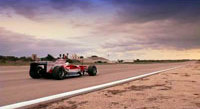Toyota’s search for the secret weapon
 |
| Click image to watch video |
Formula 1 is the sport that never sleeps and at Panasonic Toyota Racing's headquarters in Cologne, Germany, dedicated technical experts are working flat-out around the clock in the constant search for extra performance. Whether it is testing new parts in the wind tunnel, analyzing the latest track data to squeeze more performance out of the TF108 or challenging conventional wisdom on the drawing board, the quest for improvement never ends.
Several times a year the team introduces a major revision to its car, as has happened already in 2008 for the Australian and Spanish Grands Prix, but beyond that small modifications are made to the car for virtually every race and test, in line with the Toyota Way concept of kaizen; continuous improvement.
These aerodynamic improvements may not always be immediately visible – a small tweak to the angle of a wing flap or a minor change to the shape of a part – but small steps can make a big difference, while mechanical changes are nearly always hidden under bodywork. The development of the TF108 encompasses a journey across Europe and beyond in the hunt for the Formula 1 holy grail; a secret weapon to leave the opposition trailing in your tire tracks.
Cologne is the nerve centre of this high-tech, high-intensity operation but a Formula 1 team's reach is far and wide, to include suppliers from three continents and full test days in six countries in 2008 as well as aerodynamic tests on Menorca and in Lommel, Belgium. One look at the Panasonic Toyota Racing test team's activities in 2007 gives an indication of the dedication involved: more than 5,000 laps of official testing over 52 days, with five different drivers at the wheel.
Everyone involved is working together with one aim: to succeed in Formula 1. That is no easy task considering all other teams are working equally hard to catch up or stay ahead of the competition but, throughout its business, Toyota has shown a challenging spirit and is constantly seeking innovation, making Formula 1 the perfect playground.
No stone is left unturned in this effort because, as Chief Engineer Race and Test Dieter Gass explains, even the smallest improvement can have a real impact on the final result…
"If you have something in your pocket which improves car performance, even if it is only a tenth of a second, it is going to be very, very worthwhile any time in the season. The field is so close together even a tenth or two can make a very big difference at the end of the race."
But, after an exhaustive 12-month development process to get a new car from drawing board to race track for the first tests of the season, where does a team find these improvements?
With engine development frozen and a standard ECU, constant improvement in terms of engine performance is difficult – but not impossible. The opportunities for a major breakthrough in this area may have reduced dramatically in recent years but the work does not stop.
Senior General Manager Engine Luca Marmorini says….
"We work hard so our engine performance improves during the season, even considering the regulations. We have looked at how we use the engine, concentrating on factors which do not directly affect lap time but are still a major part of a car's performance over a race. So we work on improving fuel efficiency for example because, even though this doesn't bring extra speed, it still has an impact on our overall result."
Bigger gains can be made with aerodynamics, with the delicate balance between top speed, good grip and steady balance always offering room for improvement. The chassis design team set themselves a highly-confidential target for aerodynamic efficiency at the start of the season – and then expect to improve significantly with each new package.
For the Spanish Grand Prix package, this involved new camera mountings on the side of the nose as part of a new front wing, as well as a redesigned engine cover and exhaust outlets, and new rear rim covers. This will be further optimized with more new parts in Turkey, as part of the ongoing development program.
As Team Manager Richard Cregan explains, this process of continuous improvement is absolutely essential to remain competitive in Formula 1.
"If you're not bringing something new to every race of the season you're just going to be moving backwards," he says. "Just trying to stay in the same position in comparison with the other teams would be very difficult. So every race you need to be putting something new on the car. You need to be coming with some new ideas, perhaps revolutionary ideas, and whoever is doing that it the team that is going to be on top."
At Panasonic Toyota Racing, a thirst for innovation motivates the team's highly-skilled engineers, who never cease trying to break new ground. Richard adds…
"What you're trying to achieve, in many respects, is to really come up with something revolutionary. Not purely an evolution of something that exists because the only way you're going to get out there and win is with something new. That's how it evolves over the whole season because Formula 1 doesn't stand still."
